|
|
Lottery

|
|
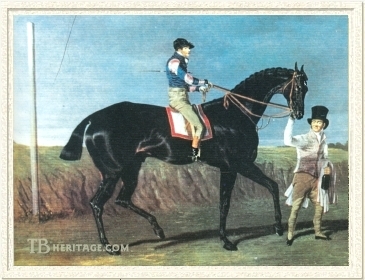 |
|
|
Lottery was a talented racehorse that, due to temperament and mismanagement, did not live up to his promise as a racehorse. He was a great stayer and weight-carrier, and passed these traits on to his offspring. As a sire, he was the Tramp son to pass on this sire line branch of Eclipse, although his lasting influence on the breed was through his daughter, Rebecca, the dam of the great racemare and producer, Alice Hawthorn. He also had a long-term influence on steeplechaser breeding in England and Ireland through his sons Verulam and Sheet Anchor.
Lottery's dam, Mandane, was born in 1800, out of the Woodpecker daughter, Young Camilla, who had won on the turf. Woodpecker won eleven of his twenty-two races, and did very well in the stud, with 179 youngsters earning over £76,000; his son, Buzzard, sired three good sons in Castrel (1801), Selim (1802) and Rubens (1805). Mandane's sire was the successful racehorse -- winner of 34 races -- and sire, Pot-8-Os.
|
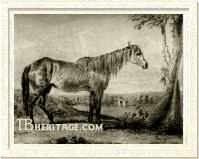
Mandane
| |
Despite having a sire and broodmare sire who were among the top stallions of their day, Mandane was a dud on the racecourse, her sole win a 50 guineas match at Brighton at age three, beating a two year old. However, in the breeding shed at Richard Watt's Yorkshire Bishop Burton stud farm, Mandane became a very influential mare, producing two classic-winning daughters, Oaks winner Manuella (1809, by Dick Andrews), and her sister, St. Leger winner Altisidora (1810). Both daughters bred on, and Manuella, in addition to being the dam of St. Leger winner Memnon, also bred by Watt, produced York St. Leger winner Belzoni; Belshazaar, who sired a classic winner; and daughters who became tail-female ancestresses of such horses as American Triple Crown winner War Admiral, and Ascot specialist Fisherman.
|
| In addition to her two classic-winning daughters, Mandane had eleven other live foals, most of which were winners on the turf, including Captain Candid (1814, by Ceberus, second in the Doncaster St. Leger); Procurante (1816, by Langton, Sapling Stakes winner); Muta (1819, by Tramp, winner of the Sapling Stakes and Produce Stakes at York); Lottery, and Brutandorf (1821), by Blacklock, Chester Cup winner and sire of some good stakes winners, including Hetman Platoff, Physician and the Grand National Steeplechase winner Gaylad). A source of stamina and speed, she was the common ancestress of a number of good steeplechasers; thirteen Grand National Steeplechase winners descended from her within six generations. Of these, seven descended from her son, Lottery.
|
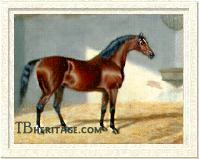
Tramp
| |
Two of Mandane's foals -- Lottery and his sister, Muta -- were sired by Tramp, who had been bred and raced by Watt, and then sold after his retirement to the stud, eventually ending up in the ownership of Robert Ridsdale at whose stud was located near Murton in Yorkshire. He was by Dick Andrews, who won some races at Chester and elsewhere, and was out of a mare by Gohanna. Tramp was a top four-mile racehorse who ran exclusively in the north of England, winning a number of cup races at such venues as York, Pontefract, Beverely and Doncaster. |
He became an extremely successful sire, his offspring winning over £67,500. Among his get were two Derby winners, St. Giles and Dangerous, the St. Leger winner Barefoot, two 1,000 Guineas winners, and two winners of The Whip, Zinganee and Little Red Rover.
Lottery on the Turf
Lottery, initially named Tinker, was an attractive, 16 hand tall, horse with a nervous temperament, aggravated by the relentless training he underwent ..."though the spirit was nearly galloped out of him, his courage was never subdued." He did not start at age two, displaying various undesirable behaviors, such as getting down and rolling when he couldn't rid himself of his rider in any other way. Watt was reputed to have considered having him shot because he was "so apprenhensive of serious mischief."
Lottery was among the 27 horses that first started for 1823 St. Leger; after three false starts, twenty-three broke for the fourth start and ran the entire course, after which a fourth false start was ruled. Lottery, his jockey John Jackson said, showed "very bad temper" and "would not make any effort to run," and he was withdrawn, as were fifteen others, from the race, ultimately won by Barefoot, who was another Tramp colt bred and owned by Watt, from whom Lottery could "run clean away" in private trials.
Watt sold the colt for 450 guineas to Thomas Whitaker of Dowthorpe Hall, near Ellerby in Yorkshire's East Riding. His always uncertain temper was exascerbated under his new owner, he was "miserably treated and mismanaged, serving mares and being only half trained at the time he was engaged to compete in long courses and with some of the best horses of his time." Despite this, when he could run, he was outstanding, and some considered him "the horse of a century," who gave "splendid exhibitions of courage and speed" in his races.
In 1824, age four, he ran fifth and last to his half-brother, Abron (Whisker - Mandane) in a sweep at York. He next ran at Newcastle over four miles, winning the King's Plate there. Back at York in August, he won a race beating Abron by six lengths, and went on at the same meet to win the Cup by ten lengths. He ran second to Buzzard in the Fitzwilliam Stakes at Doncaster, and then ran second for the Doncaster Cup to Mercutio, beating Buzzard, 1822 St. Leger winner Theodore, his half-brother Brutandorf, and three others. Also at Doncaster he beat Barefoot at even weights. His last race of the season was the Lincoln Cup, where he ran second to the Camillus filly Minna.
When he was five, he started by running second to a Filho-da-Puta son, Osmond, over two miles at York, and several days later won the York Cup. He ran second to Barefoot for the Lancaster Cup, and then won the Cup at Preston in July. Back in York in August, he won the Fitzwilliam Stakes this year, in a canter. At Doncaster, he won the Fitzwilliam Stakes, beating Figaro and seven others, and followed that by winning the Doncaster Cup, beating the good horse Longwaist by a neck, and nine others, leading all the way. He went on to Lincoln, where he again lost to Minna for the Cup. He did not place in his last race that season.
In 1826 he debuted at York spring meeting in very poor shape: "...his condition was so bad as to excite the public indignation, which vented itself in exclamations of 'Take him away, he is not fit to run a yard." He didn't place in a sweep there, won by the four year old tough race mare Fleur-de-Lis, in which he carried 9 st. 4 lbs. to her 7 st. 13 lbs. That race was followed by another tough one against Humphrey Clinker, where he ran second. He was moved on to Preston, where he again won the Cup there, beating Brutandorf and two others. His career closed with four successive races in which he ran unplaced.
In all he won eleven races. A contemporary turf observer wrote, "Never was a horse so shamefully messed about as was Lottery. Naturally erratic and queer-tempered in his disposition, his defects were sadly aggravated by neglect and mis-management; otherwise he would have been one of the most brilliant performers on the British Turf."
Lottery in the Stud
Lottery spent seven plus years at stud in the north of England, before being sold to France. He sired one English classic winner, St. Leger winner Chorister. As a rule, his offspring seldom ventured beyond the venues of northern England to race; he was, in effect a regional sire who got stayers that won at Doncaster, Liverpool, Northallerton, York, Chester, and other northern courses, although some did venture to and win at Ascot, Goodwood and Epsom, almost always as handicappers in distance races.
He left his son Sheet Anchor in England to continue the Joe Andrews branch of the Eclipse sire line, and his daughter Rebecca, dam of the great race mare Alice Hawthorn, to influence generations of thoroughbreds in tail-female descent. Lottery was sent to France in 1834, where he stood for the French government at the Bois de Boulogne with Cadland and Physician. He sired some good stayers in France, and he was followed there by his son Alteruter, who got some very good runners, and a number of daughters by his son Inheritor made their mark on the French turf. His son, Consul, sent to the U.S., got one of that country's great racemares, Miss Foote, and two Lottery daughters had an influence on American breeding, particularly his daughter Frolicsome Fanny, the dam of the great racemare Nina, who produced one of America's best pre-Civil War racehorses, Planet. His blood also flowed in seven Grand National Steeplechase winners and a number of other good 'chasers within six generations, including his own son, Lottery, the first to win that event. |

Chorister
| |
CHORISTER was born in 1828, out of a mare by Chorus, a bay colt standing about 15.3 hands. He was bred by John Smith and sold as a yearling for 300 guineas to William Henry Vane, 1st Duke of Cleveland. At age two he was a bit on the small side, and said to resemble his sire at the same age. He won his first race as a juvenile at York, a sweepstakes for two year old colts and fillies, besting ten other youngsters after several false starts, during which he "exhibited his impatience at these disappointments, by giving some good hearty kicks, which made it necessary to keep at a respectful distance." He did not place in his next race, the Champagne Stakes at Doncaster, won by the Victoire, the horse he beat into second in his first outing. |
|
At age three, Chorister won the Short Stakes over a mile at York spring meeting, beating The Saddler, who had won the York St. Leger the previous day. In August, he won a race at York over the good mare Fortitude and three others. He next went to Doncaster, where he won the St. Leger, beating twenty-three other horses in an exciting driving finish from the outside to best The Saddler by half a length. The field included Liverpool, Colwick, and other good horses, including three other youngsters by Lottery, La-Fille-Mal-Gardee (later named Hope, from Morgiana and so sister to Sheet Anchor), Lady Elizabeth, and Tetotum, who finished third, fourth, and sixth respectively. Also at Doncaster, he dead-heated with Liverpool, giving him four pounds, in the Gascoigne Stakes, which he lost by a length in the deciding heat. The last race of his career was the two mile Northallerton Cup, which he won, beating Lady Elizabeth and one other. He died early, and left no youngsters to breed on. |
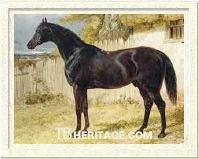
Sheet Anchor
| |
SHEET ANCHOR was bred by J. Golden, from his Muley daughter, Morgiana, in 1832. He matured to 16 hands, with substantial bone. He wasn't particularly attractive, and had a heavy shoulder and powerful quarters. He ran his first season, age three, under the name "Brother to Hope." He was a good, if lightly raced, runner, who ran in good company, and he was the Lottery son to continue the Joe Andrews sire line by getting Weatherbit (out of Oaks winner Miss Letty), the sire of Beadsman. He was, like his sire, primarily a sire of stayers.
|
His first race was the Sapling Stakes for three year old colts at York, which he won with little preparation. His next race was the Doncaster St. Leger, in which he ran third to Queen of Trumps and Hornsea, beating the 1,000 Guineas winner Preserve and the one-two Derby winners of that year, Mundig and Ascot. At Lincoln he won the Cup, beating one other horse, a filly by Brutandorf. He was sold after that race to J.H. Cookes, and assumed his new name, Sheet Anchor.
In 1836 he won his only race of the season and last race of his career, a handicap sweepstakes at Newmarket, beating a good field which included Goodwood Cup winner Hornsea, Liverpool July Cup winner Birdlime, and the 1835 Leamington Stakes winner Revenge, and three others. He was retired to the stud in Yorkshire, and stood first at Fairfield Lodge, and later at Rawcliffe Paddocks, near York, and became a fairly popular and successful sire of horses that ran and won primarily in the north of England.
His best sons were Weatherbit (1842, out of Oaks winner Miss Letty, by Priam) and Collingwood. Weatherbit, who was owned by the ex-pugilist John Gully, resembled his sturdy-looking sire, and was probably a better horse on the turf, winning the Welcome Stakes at Ascot at age three, beating Jericho, July Stakes winner Old England, and other good horses, but not placing in either the Derby or the St. Leger. At age four he won a sweepstakes at Goodwood, beating a good field that included the 1,000 Guineas winner Pic-Nic and the Derby runner-up, Annandale. He also ran second to Miss Elis for the Goodwood Cup in 1845, second to Chamois in the Great Metropolitan Stakes at Epsom in 1846, and second to King of Morven in the 1847 Craven Stakes at Newmarket. He got some good winners, almost all stayers; his most significant was Derby winner Beadsman, who sired two classic winners, Pero Gomez and Blue Gown, and a versatile winner in Rosicrucian, as well as some good daughters, Green Sleeve, and Morna, who ran second in both the 1,000 Guineas and the Oaks.
Sheet Anchor's son, Collingwood, was a great stayer who ran in seventy races. He was a bay colt of 1843, out of the Magistrate daughter Kalmia, bred by George Payne. At age two he won four matches, one against another Sheet Anchor youngster, the filly Astern, and received two forfeits in other matches, but ran unplaced in both the Lavant Stakes, and Newcastle's Clearwell Stakes, both won by Sting. At age three, he ran second to a colt by Bay Middleton in a handicap at Newmarket, and second to Peasant in another handicap in Newmarket's First Spring meet, then won the Cowdray Stakes at Goodwood, and was claimed during that race by a Mr. P. Rolt for £150. That year, 1846, he won two more races, lost a match, and ran unplaced in six more efforts. The next year, age four, he won the Chesterfield Cup and ran second in the Stewards' Cup at Goodwood, and third in the Cambridgeshire Stakes handicap. At age five he won both the Grosvenor Stakes and the Stand Cup at Chester, and the Oatlands Handicap and another race at Newmarket. The next year he won twelve races, including two forfeits and a walk-over, his victories including Northampton's Trial Stakes, Ascot's Trial Stakes and the Royal Hunt Cup. In 1850, age seven he won eight races, among them Epsom's Craven Stakes and the Dundas Stakes at York. His daughter, Polly Peachum, produced 1873 Grand National Steeplechase winner Disturbance. Another daughter, Golden Pippin (1855), produced the Deutches Derby and Henckel-Rennen winner Investment (1866).
Sheet Anchor also sired Kedge (1838), who won the Champagne Stakes at Doncaster at age two; Afcanus (1839), winner of the Cesarewitch; Lightning, who won the Liverppool July Cup in 1846; Sally, who won the Park Hill Stakes at Doncaster, and ran second to Alice Hawthorn for the Northallerton Cup and for the Richmond Cup. Another son, Malton, won the Chester Cup in 1849, and later was sent to New Zealand as a sire. A daughter of Sheet Anchor's, was Laelia (out of Cotillion, by Partisan), who was sent to Ireland where she was second dam of the half-bred Irish steeplechaser, Zouave, who in term sired the dual-Grand National Steeplechase winner, The Lamb (1868 and 1871).
Other sons of Lottery included CONSUL (1828), out of a Cerberus mare, who was a good stayer; his wins included the Great Subscription Purse at York, the Gold Cups at Preston and Lancaster, a King's Plate at Doncaster, and Liverpool's Stand Cup and July Cup. He also ran third to Rockingham in the Doncaster Cup of 1833, second to Tomboy in the Doncaster Cup of 1834, and third to Touchstone and Rockingham in the Ascot Gold Cup 1836. He was purchased by Huntsville, Alabama, breeder Elijah Boardman, who brought him to the U.S. in 1835, where he had a short stud career, dying in 1839, but not before he left his good daughter, Miss Foote (1838), a tiny (14-1/2 hands) blood bay filly of great heart and speed who set records for both a mile and three miles in the U.S., and won 13 of her 15 races, one of the most celebrated mares of her time; after her purchase by her trainer, she was taken to Texas and her progeny, if any, are not recorded. He also got a son, Hamlet, bred by Boardman, grandsire of the great American broodmare, Dixie, and Shamrock, a son of his imported by Boardman in-uterobecame the sire of another great American broodmare, Hennie Farrow (dam of Mollie McCarty, Flood and Shannon).
Consul's owner in England, D. Robertson, also ran another Lottery colt, LUCIFER (1832), out of a Macaroni daughter, Pimlico. At age three, in 1835, he won the Gold Cup at Epsom, the King's Purse at Ascot, a King's Plate at Goodwood, and the Gold Cup at both Egham and Abingdon; that year he also won the Brighton Cup, beating the 1833 St. Leger winner Rockingham, who had been eased when 12 lengths ahead of Lucifer, and was off-stride when caught by the steadily running Lucifer.
|
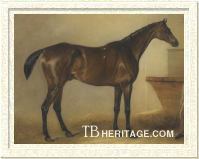
Zohrab
| |
The longest-running of Lottery's sons was the gelded ZOHRAB (1831), who raced in eighty-six events, first for the Duke of Leeds, and later for James Fairlie. Among his best wins were the Eglinton Stakes and the All-Aged Stakes at Eglinton Park and the Irvine Cup. Another son, RED ROVER, ran in the north, winning the Manchester Cup, and placing second to Birdlime in the Chester Cup of 1835. Another Lottery son who won the Manchester Cup was THE CARPENTER (1833), who was also a fair juvenile in north country races. LUCK'S ALL (1832), a grey colt owned first by Robert Ridsdale and then by Lord Exeter, ran in good company placing second to Venison in a King's Plate at Goodwood, and running third to Venison and Amesbury in the Brighton Stakes. CAVENDISH (1832), another grey Lottery son, ran second to Hornsea in the St. Leger Stakes at Heaton Park in 1835.
|
ALTERUTER (1831, from an Orville Mare), was an indifferent performer, and was sent to stud in France, where he sired some good horses, including Lioubliou, who won the Poule des Produits (later Prix Daru) over 2,000 meters in 1848; Nanetta (out of Margarita) who won the Prix du Cadran for Thomas Carter; and Meudon (1842, out of Margarita), who won the Prix du Jockey Club and other good races for Baron Nathan de Rothschild.
Lottery's son INHERITOR (1831), a black colt from Handmaiden, a Walton daughter, won the Liverpool July Cup. He was a useful sire and broodmare sire. His daughter, Bounty (1849), won the French Oaks and the French 2,000 Guineas; her son by Lanercost, Gustave, also won the 2,000 Guineas in France. Inheritor's daughter Coheiress (1841, from Hygeia by Physician), won the Great Ebor Handicap. His daughter Creeping Jenny (1847, out of Maid of Erin), was sent to France in 1851; she produced two French classic winners, Prix du Jockey Club (French Derby) winner Black Prince (1856), and Stradella (1859), who won the French Oaks and the French 2,000 Guineas. Another daughter, Fair Rosamond (1841), was the dam of Prix Lupin winner Choisy Le Roi. Inheritor's daughter Nan Darrell (1844, out of a Blacklock mare), was the second dam of 2,000 Guineas and dual Doncaster Cup winner Vedette, who later went on to sire Galopin; a number of classic winners and good stakes winners descend tail-female from Nan Darrell (Family 19 - b), including the Kentucky Oaks winner Lalun and her two sons, Never Bend and Bold Reason; the Italian crack of the mid-1970s, Sirlad; dual classic winner Windsor Lad.
Lottery's son VERULAM (1833) was bred in Ireland from the Waxy daughter, Wire, who was imported there by Lord Sligo. He got some good horses in Ireland. His daughter, Gruyere, became the dam of Ascot Gold Vase and Great Metropolitan Handicap winner Parmesan, who later sired two Derby winners. Another daughter, Michaelmas Daisy (1845), out of Kiss, by Waxy Pope, produced Revolver, who won steeplechases in Ireland and was the sire of the 1887 Grand National Steeplechase winner, Gamecock. Verulam himself sired a Grand National Steeplechase winner, Wanderer, bred by Mr. Holmes, who won in 1855.
Verulam also sired Vulcan, who was also bred by Holmes, from the Teniers daughter Puss, in 1837. At the age of three, Vulcan won three races in Ireland, and had a walk-over for the Wellington Stakes at the Curragh, and ran second twice, at distances between two and four miles. With these successes under his belt, he was sent to England, where he lost some races, but won a small race at Warwick and then handily won the Cambridgeshire Stakes handicap, beating Cesarewitch winner Iliona, Cruiskeen, Pocahontas, and others. In what appears to be some sort of gentleman's agreement, he was sold temporarily to Lord Miltown to run in several matches, two of which he won, against Scutari, and against Camelon, after which he was re-sold to Holmes. Of his other races up until he broke down in the running of the Leamington Stakes in 1843, he won the Shrewsbury Cup (2-1/2 miles), the Cheltenham Cup, and the Liverpool Cup, plus assorted sweeps and other races.
Lottery's Influence on Jumpers
The Druid noted that "nearly all the Lotteries had a strong Chase as well as Turf stamp about them." No less than eight winners of the Grand National Steeplechase at Aintree descended from Lottery within six generations. They were his son, Lottery (1829); Wanderer (184-), Cortolvin; Gamecock (1879), descended from his son, Verulam; Grudon (1890), who descended from Alice Hawthorn's dam, Rebecca; and Disturbance (1867), the great dual winner, The Lamb (1868 and 1871), and the steeplechase mare Frigate (1878), all of which came through Lottery's son, Sheet Anchor. See this chart for Mandane's descendants.
|
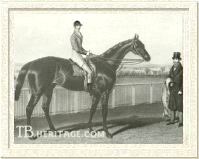
Lottery's son, Lottery, was the most famous steeplechaser in England
| |
Lottery's gelded son, also named Lottery, but first called "Chance," won the first Grand National at Aintree, then called the Grand Liverpool Steeplechase, over four miles, which had been reorganized and funded by a new syndicate that year of 1839. Lottery was born in 1829, out of Parthenia, by a Soothsayer son, Welbeck (out of Pledge, a daughter of the famous Prunella). His dam's lineage is unknown, and she was assigned the half-bred family number B-14. Lottery was bred by Mr. Jackson of Thirsk; he was a "mealy" brown-bay color, with a deep girth and narrow, short quarters, standing 16 hands when mature. For whatever reason, possibly linked to his sire's temperament problems, Lottery could not stand the sight of his partner, jockey Jem Mason, and a number of tricks were employed to allow Mason to mount him, although once on, they became an almost unbeatable team over fences. |
Lottery was slow to mature, and did not start until age four, when won a minor flat race at the Holderness Hunt meeting. After that was put up for sale at the Horncastle Fair, a long-established sales venue for hunters and jumpers, where he was purchased by John Elmore, a steeplechasing enthusiast, for 120 guineas. His first race over fences was at Finchley in December of 1836, where he fell. He came in third in the St. Albans steeplechase in 1837, and after that he started to win at meets all over the country, including the Cheltenham Steeplechase in 1839 and 1840, the Daventry Grand Steeplechase in 1838, and steeplechases at Maidstone, Barnet and Stratford. For most of his career he was trained at Epsom by George Dockeray, and ridden by Jem Mason, who became Elmore's stable jockey, and later his son-in-law.
In 1839 Lottery won the Grand National (Grand Liverpool), then a race for even weights. In 1840, within the span of a month, he ran six times in steeplechases held in widely separated areas of the country, to which he was walked; all the races were over four miles, and he carried 12-0 in all but one, Cheltenham, where he carried 13 st. - 3 lbs. Of the six races, he won four, at Leamington, Northampton, Cheltenham, and Stratford; the other two were Fakenham and Liverpool, where he fell, as did several other horses, at the stone wall.
A very tough and game horse, his career spanned eight seasons, during which he won five hurdle races and sixteen steeplechases. He was so successful that course clerks wrote rules to specifically cripple him with handicaps, such as at Liverpool in 1841 and 1842, wherein it was specified that the winner of the Cheltenham Steeplechase of 1840 (e.g. Lottery) would be required to carry an additional 18 pounds (in this race was pulled up). At Horncastle the race was "Open to all horses except Mr. Elmore's Lottery." Lottery's attempts to win the Grand National in 1842 and '43 were also unsuccessful; he was pulled up in 1842 (won by Elmore's Gaylad, by Mandane's son Brutandorf), and ran seventh in 1843, the first time the race was handicapped for all horses (won by Mandane's grandson, Vanguard, by Belzoni), carrying 12-6, the last time he ran in that race. The last race of his career was at Windsor in April, 1844. For some time after his retirement, he served as his trainer's hack. Later, he was sent to a Mr. Hall, who had a pack of harriers at Neasden, and it is said he was put to ploughing when he was "too much played-out to stand cross-country work." He was buried at Astley Grange Farm stud at East Langton, Leicestershire.
Two stories were told about Lottery. One is that he was schooled to impress visitors to the Elmore home by jumping and clearing the furnished table on which lunch was already set. The other is that, long after his retirement, when he was age 20, he was visited by his long-time partner, Jem Mason, and "...the old horse recognized his voice before the box door was open and gave him a most vicious and unflattering reception."
Lottery's Daughters
Lottery's daughters, as a rule, were not particularly good on the turf, and the few that were won best at a distance. However, he got a few really top broodmare daughters who proved influential in both England and America.
His best daughter on the turf in England was probably LADY ELIZABETH (1828) from the Cervantes mare, Miss Wentworth. She was described as "a very fine filly with excellent racing points." At age three she won a total of £800 at Newmarket, the Gold Cup at Richmond, and she ran third in a sweep to The Saddler at York. At age four, she ran second to Lottery's son Consul in the Liverpool Cup, beating such colts as Colwick, Birmingham and Physician, but ran unplaced in Galopade's Doncaster Cup. In the stud she became the second dam of Cesarewitch winner Muscovite, by Hetman Platoff. Lottery also had a good staying daughter in TOMATE, who was bred in France, after he was exported there (see below).
In England, Lottery's daughter THE MYSTERY (1830, from Miss Fanny, by Walton), produced Disclosure, who won the Park Hill Stakes. His daughter REBECCA (1831), from a mare by Cervantes, became an outstanding producer, whose sons The Provost (1836, by The Saddler) and Annandale (1842, by Touchstone) were good horses on the turf, and whose daughter, Alice Hawthorn (1838, by Muley-Moloch), became one of the most celebrated mares on the English turf. Alice Hawthorn later produced Derby winner and sire Thormanby, a good racehorse in her son Oulston, and several good daughters, some of whom became dams of stakes winners and broodmares who continued Alice's family line. Other Lottery daughters are seen in tail-female descent of a number of good horses, such as RECTITUDE (1832, from Decision), second dam of Ascot Gold Vase winner Sedbury, and MISS WILFRED (1830, from a Smolensko mare), from whom such horses as Native Dancer descend in tail-female line.
Two Lottery daughters became influential broodmares in the U.S.: Frolicsome Fanny and Heads or Tails. They were part of a large number of mares, numbering over 200, and stallions, totaling over 80, who were imported into the U.S. from England in the 1830s. They were brought over by bloodstock firms and private owners anxious to introduce fashionable English bloodstock and reinvigorate American lines that hadn't received much outside blood for over twenty years. For the most part, unlike earlier importations, very good horses were purchased in their prime for top dollar, from leading stables in England.
|
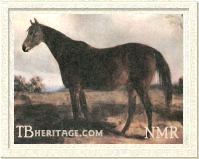
Heads or Tails was sent to the U.S. Permission granted by the National Museum of Racing.
| |
HEADS OR TAILS was bred by George Pigot in England in 1831, out of a Partisan mare named Active. She was in the U.S. by 1839, and dropped a foal by English Cain in 1840. Her owner, Henry Clay, Jr., of Kentucky, had her located at James Jackson's plantation, Forks of the Cypress, in Alabama, where Jackson stood Glencoe, to whom she was bred, producing a bay filly, Heads I Say, who later became a broodmare at R.A. Alexander's Woodburn Farm. There she produced Woodburn (1861) and his sister Hester (1866), both by Lexington. Woodburn, sent to California, was sire of the good race mare Geraldine, and Hester produced, to the cover of Australian, the chestnut Springbok (1870), winner of 17 of his 25 races, including the Belmont Stakes, and champion handicap horse in the U.S. at age four, winning at distances up to three miles. |
FROLICSOME FANNY (1832) was bred by Thomas Kirby out of a Whisker mare, a full sister to Catterick. She was imported into Alabama in the 1830s, and eventually ended up in Kentucky, where, in 1848, she produced Nina, by Boston, bred by B.P. Grey. Nina became a top racemare, running first at the age of three in Charleston, South Carolina, and, passing through the hands of several owners, bested some very good horses. Purchased by Major Thomas W. Doswell of Virginia, she beat her paternal half-brother, Red Eye, one of Boston's best sons, in one of their three matches in 1853. She won several times in 1854, including a walk-over for the Jockey Club Purse of $1,000 in Charleston, and several three mile wins in Charleston and Georgia. After breaking down in the spring of 1854, she was bred to Revenue, producing Planet, the following year, who was, in historian John Hervey's assessment, the best race horse between Lexington and the Civil War, winning 27 of his 31 races and becoming America's all-time leading money winner. Planet, who stood at Alexander's Woodburn Farm alongside of Lexington and Australian, he is best known as an influential broodmare sire, seen in the pedigrees of Regret, Exterminator and other good U.S. horses.
Nina produced a total of 15 foals, living to the age of 31. Her son Algerine (1873, by Abd-El-Kader) was foaled when she was age twenty five; he won the Belmont Stakes, among other races, and in the stud sired a good race filly, Aurelia. Another daughter of his, Margerine, became the dam of Rhoda B., whose son, Orby, won the Epsom Derby, and whose daughter, Rhodora, won the English 1,000 Guineas. Through her daughter Ecliptic (1867), Nina is seen in the tail-female line of the 1952 U.S. Champion colt, One Count ( 1949, by Count Fleet), and other good horses.
|
Lottery was one of a succession of English thoroughbreds imported in the 1830s into France, most of them from Norfolk or Yorkshire. In 1833 Henri Lacase, a buyer for the French National stud of the Orleans monarchy (1830-1848), purchased the Bob Booty son Napoleon, the Andrew son Cadland, and Lottery, all of whom arrived in France in 1834. Lottery went first to Paris, and then was transferred to Haras Le Pin in 1835. He spent the 1836-37 seasons at Angers, went to Paris in 1838, and returned to Le Pin for the last three years of his life, dying in 1845.
He was a useful stallion in France, but had nowhere near the success of his contemporaries, Royal Oak and Napolean, or even Cadland. His best was probably the filly TOMATE (1842, from Elvire), who was owned by Monsieur Fasquel. She ran second to the great Suavita, a Napoleon daughter, in the Prix de Diane at age three, and at age four won the 2500 meter Prix du Cadran, the Handicap d' Autum, and two royal plates, one at Nantes, and one at Pompadour. She produced nothing of note in the stud.
Other good Lottery offspring on the turf included QUINE (1838), who won the Prix Royal Oak for F. Sabathier, and three races in Bordeaux: the Prix Special, the Prix Royal, and the Prix duc d'Orleans; ANGORA (1839, from Young Mouse), owned by Monsieur A. Lupin, who ran second in the Prix du Jockey Club, and won the Poule des Produits over 2000 meters at Versailles, and the Prix d'Arrondissement; and RATAPOLIS (1840), also owned by Lupin, who, at age four, won the Prix de la Ville de Paris at Champ-de-Mars, the Prix de la France, the Prix Principal, and the Prix Royal at Caen.
-- by Patricia Erigero
|
|
|
|

